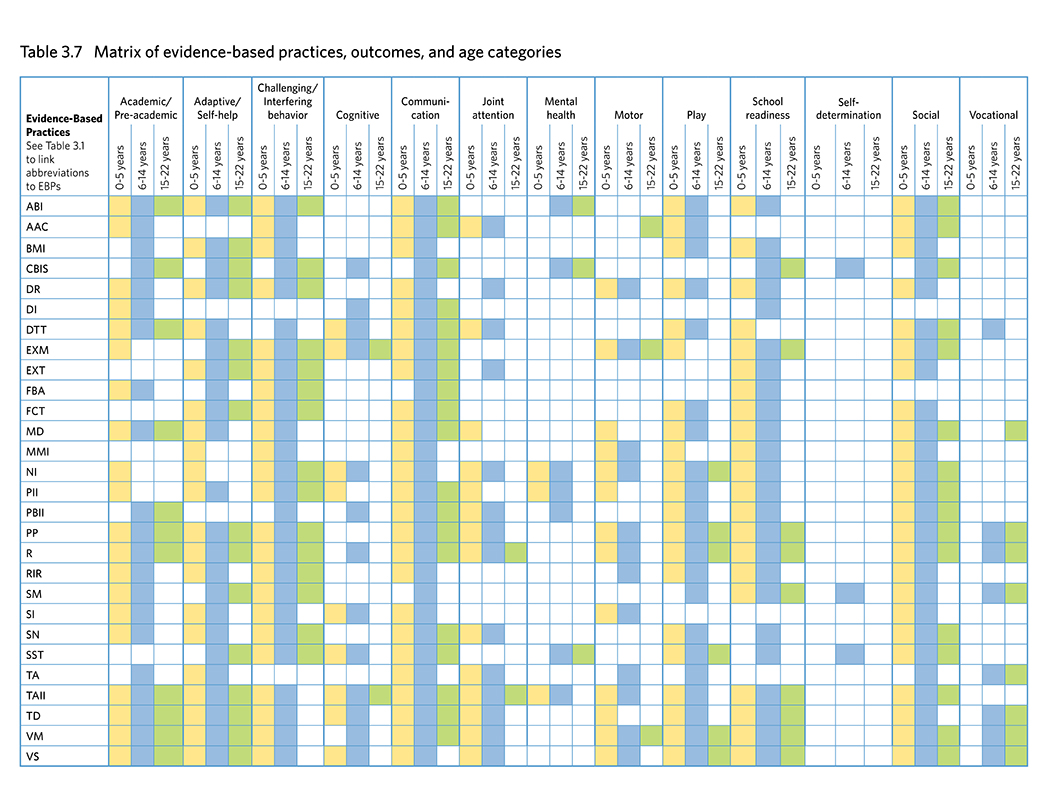The NPDC Model: Implementation
The implementation step involves selecting and using the practice.
Matching the intent of the goal with an instructional domain is a good place to start when selecting an EBP. For example, if the goal is targeting social-communication, you might want to refer to the NCAEP Age and Domain matrix (see below) as a first step in identifying those EBPs targeted by the research literature for the age of the student and the domain of instruction. While this format provides professionals with information on which practices might be useful in targeting certain skills, it is not meant to be restrictive. Teams are encouraged to begin the selection process by identifying a single EBP to use with an individual goal. This is especially helpful for teams who are hesitant about the process and/or less confident in their teaching skills. However few practices are used in isolation. Prompting and reinforcement, for example, are used in almost all of the other practices.

Download the Matrix of Evidence-based Practices by Outcome and Age (PDF)
Self-learning Materials
The selected EBP will need to be implemented with fidelity. Several professional development and coaching resources are available for professionals to ensure implementation fidelity.
The NPDC developed AFIRM (Autism Focused Intervention Resources and Modules). AFIRM includes engaging self-learning resources and modules for each of the 27 EBPs. Each module follows a three-step process for learning about practices. These steps include planning, using, and monitoring the use for the designated EBP. Engaging case studies, video examples, and interactive activities illustrate each EBP. Read more about AFIRM.
The following self-learning materials are currently available:
- Summative information for each practice identified in 2014 is available in the Evidence-based Practices section. These are called “EBP Brief Packets” and contains an overview of the practice, step-by-step instructions for implementation, implementation (fidelity) checklists, evidence base, and sample data collection sheets.
- The Autism Spectrum Disorder (ASD) Toddler Initiative expanded the work conducted by the NPDC by creating additional module resources on EBPs for young children (brith-3) and their families. These learning materials include practice scenarios for how to use the practice in home- and center-based settings and lead the learner through the three-step process of using each practice.
- The Center on Secondary Education for Students with Autism Spectrum Disorders (CSESA) has developed online case studies to supplement resources developed by the NPDC. These case studies apply specific evidence-based practices to high school students with ASD.
- The NPDC developed content for online modules for many EBPs for the Ohio Center for Autism and Low Incidence (OCALI). The Autism Internet Modules (AIM) website features content on these EBPs as well as on other topics of interest such as assessment and identification, characteristics, transition to adulthood, and employment.
Trainings
The team should inquire about resources (staff with expertise, professional development time) within the school and district that can be used to support the instruction that is needed. For example, if training is needed, inquire about what resources are available to support professional development time for staff.

